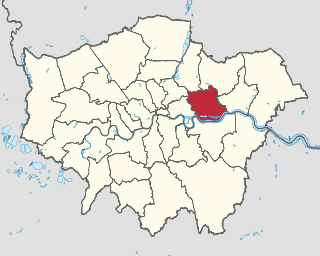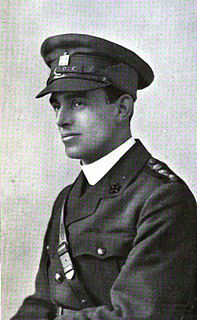
The London Borough of Newham is a London borough created in 1965 by the London Government Act 1963. It covers an area previously administered by the Essex county boroughs of West Ham and East Ham, authorities that were both abolished by the same act. The name Newham reflects its creation and combines the compass points of the old borough names. Situated in the East London part of Inner London, Newham has a population of 387,576, which is the third highest of the London boroughs and also makes it the 17th most populous district in England. The local authority is Newham London Borough Council.

Samuel Augustus Barnett was a Church of England cleric and social reformer who was particularly associated with the establishment of the first university settlement, Toynbee Hall, in east London in 1884. He is often referred to as Canon Barnett, having served as Canon of Westminster Abbey from 1906 until death.

Geoffrey Anketell Studdert Kennedy was an English Anglican priest and poet. He was nicknamed "Woodbine Willie" during World War I for giving Woodbine cigarettes to the soldiers he met, as well as spiritual aid to injured and dying soldiers.
Edward Michael Bankes Green was a British theologian, Anglican priest, Christian apologist and author of more than 50 books.

James Hudson Taylor was a British Protestant Christian missionary to China and founder of the China Inland Mission. Taylor spent 51 years in China. The society that he began was responsible for bringing over 800 missionaries to the country who started 125 schools and directly resulted in 18,000 Christian conversions, as well as the establishment of more than 300 stations of work with more than 500 local helpers in all eighteen provinces.

David Stuart Sheppard, Baron Sheppard of Liverpool was a Church of England Bishop of Liverpool who played cricket for Sussex and England in his youth. Sheppard remains the only ordained minister to have played Test cricket, though others such as Tom Killick were ordained after playing Tests.

The Church Army is an evangelistic organisation and mission community founded in 1882 in association with the Church of England and now operating internationally in many parts of the Anglican Communion.
OMF International is an international and interdenominational Evangelical Christian missionary society with an international centre in Singapore. It was founded in Britain by Hudson Taylor on 25 June 1865.

Stephen John "Steve" Chalke, is a British Baptist minister, the founder of the Oasis Charitable Trust, a former United Nations' Special Adviser on Human Trafficking and a social activist.
Gerard Kennedy Tucker OBE was an Anglican priest in Melbourne, Australia. Tucker founded the Brotherhood of St Laurence in 1930 and the forerunner of Oxfam Australia in 1953.
United Society Partners in the Gospel (USPG) is a United Kingdom-based charitable organization.
Mary Ann Aldersey艾迪綏 was the first Christian missionary woman to serve in China proper. She founded a school for girls in Ningbo, Zhejiang. Her pioneering the field of mission work for single women in China was the most remarkable outcome of her life.
Anthony Charles Deane (1870–1946) was canon of Worcester Cathedral, poet and writer of religious books. He was the son of H. C. Deane, a barrister-at-law. In 1898, he married Maud, the second daughter of Col. Versturme-Bunbury of Bath. He is perhaps best known as a writer of popular Christian books.
The Church of England Zenana Missionary Society, also known as the Church of England Zenana Mission, was a British Anglican missionary society established to spread Christianity in India. It would later expand its Christian missionary work into Japan and Qing Dynasty China. In 1957 it was absorbed into the Church Missionary Society (CMS).

Oxford House in Bethnal Green, East London, was established in September 1884 as one of the first "settlements" by Oxford University as a High-Anglican Church of England counterpart to Toynbee Hall, established around the same time at Whitechapel.
Stephen Charles Neill (1900–1984) was a British Anglican bishop, missionary and scholar. He was proficient in a number of languages, including Ancient Greek, Latin and Tamil. He went to Trinity College, Cambridge, and was a fellow there before going as a missionary in Tamil Nadu in British India. He became bishop of Tirunelveli in 1939. He believed in unification of all churches in South India and communion beyond denominations. He wrote several books on theology and church history.
Sir Reginald Kennedy-Cox CBE was a British dramatist and social reformer, best known for his social work in the East End of London where he founded several Dockland Settlements. Before he committed himself to this work he was a successful playwright, several of his works being performed on the London stage. He was knighted in 1930 and appointed CBE in 1944.

Hugh Osgood is a British church leader, conference speaker, author and modern church historian. He was appointed Moderator of the Free Churches Group on 17 September 2014, following the resignation of Revd Michael Heaney. He is also the Free Churches President of Churches Together in England, the Co-Chair of the UK Charismatic and Pentecostal Leaders’ Conference and the founding President of Churches in Communities International. He serves on the Councils of Reference of numerous organisations either as Free Churches Moderator or in his own right.

The Church Missionary Society in India was a branch organisation established by the Church Missionary Society (CMS), which was founded in Britain in 1799 under the name the Society for Missions to Africa and the East, as a mission society working with the Anglican Communion, other Protestants, and Orthodox Christians around the world. In 1812, the British organization was renamed the Church Missionary Society.

The Church Missionary Society in China was a branch organisation established by the Church Missionary Society (CMS), which was founded in Britain in 1799 under the name the Society for Missions to Africa and the East; as a mission society working with the Anglican Communion, Protestant, and Orthodox Christians around the world. In 1812, the organization was renamed the Church Missionary Society. The missions were financed by the CMS with the local organisation of a mission usually being under the oversight of the Bishop of the Anglican diocese in which the CMS mission operated.











